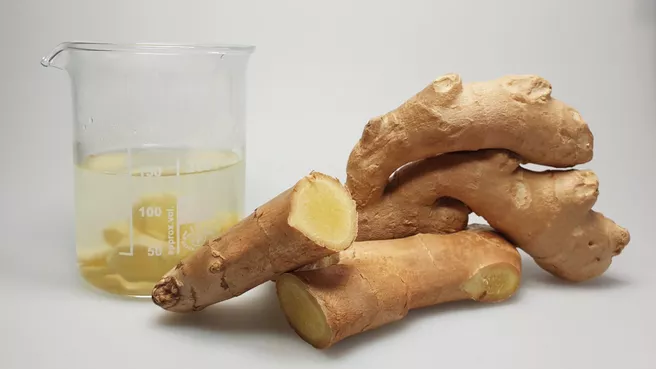Ginger compound enters the blood
To help clarify these questions, a team led by Veronika Somoza, director of the Leibniz Institute in Freising, Germany, conducted extensive research. The starting point was a result of an earlier pilot study, in which first author Gaby Andersen from the Leibniz-LSB@TUM also played a key role. As the study shows, significant amounts of pungent ginger compounds enter the blood about 30 to 60 minutes after consuming one liter of ginger tea. By far the highest levels were achieved by [6]-gingerol, with plasma concentrations of approximately 7 to 17 micrograms per liter.
The pungent compound is known to exert its "taste" effect via the so-called TRPV1 receptor, an ion channel located on the surface of nerve cells that responds to painful heat stimuli as well as to pungent compounds from chili and ginger. Since some studies suggest that white blood cells also possess this receptor, the research team tested whether [6]-gingerol influences the activity of these immune cells.
Pungent compound stimulates white blood cells
In a first step, the team succeeded in detecting the receptor on neutrophil granulocytes. These cells make up about two-thirds of white blood cells and serve to combat invading bacteria. Further laboratory experiments by the research group also showed that even a very low concentration of almost 15 micrograms of [6]-gingerol per liter is sufficient to put the cells on heightened alert. Thus, compared to control cells, the stimulated cells reacted about 30 percent more strongly to a peptide that simulates a bacterial infection. Addition of a TRPV1 receptor-specific inhibitor reversed the effect induced by [6]-gingerol.
"Thus, at least in experiments, very low [6]-gingerol concentrations are sufficient to affect the activity of immune cells via the TRPV1 receptor. In blood, these concentrations could theoretically be achieved by consuming about one liter of ginger tea," says Gaby Andersen. "So, our results support the assumption that the intake of common amounts of ginger may be sufficient to modulate cellular responses of the immune system. Nevertheless, there are still many unanswered questions at the molecular, epidemiological and medical levels that need to be addressed with the help of modern food and health research," concludes Veronika Somoza.
Publication: Andersen, G., Kahlenberg, K., Krautwurst, D., and Somoza, V. (2022). [6]-Gingerol Facilitates CXCL8 Secretion and ROS Production in Primary Human Neutrophils by Targeting the TRPV1 Channel. Mol Nutr Food Res, e2200434. 10.1002/mnfr.202200434.
https://onlinelibrary.wiley.com/doi/epdf/10.1002/mnfr.202200434
More information:
- Pilot study: Schoenknecht, C., Andersen, G., Schmidts, I., and Schieberle, P. (2016). Quantitation of Gingerols in Human Plasma by Newly Developed Stable Isotope Dilution Assays and Assessment of Their Immunomodulatory Potential. J Agric Food Chem 64, 2269-2279. 10.1021/acs.jafc.6b00030. pubs.acs.org/doi/10.1021/acs.jafc.6b00030
- TRPV1 stands for: Transient receptor potential cation channel subfamily V (for vanilloid), subtype 1.
- Link to data from the German Federal Statistical Office (Destatis): www.destatis.de/DE/Presse/Pressemitteilungen/Zahl-der-Woche/2023/PD23_02_p002.html
Scientific contact:
Prof. Dr. Veronika Somoza
Leibniz Institute for Food Systems Biology at the TUM (Leibniz-LSB@TUM)
E-Mail: v.somoza.leibniz-lsb(at)tum.de
Dr. Gaby Andersen
Research Group Metabolic Function & Biosignals at the Leibniz-LSB@TUM
Tel.: +49 8161 71-2930
E-Mail: g.andersen.leibniz-lsb(at)tum.de
Press contact at the Leibniz-LSB@TUM:
Dr. Gisela Olias
Knowledge Transfer, Press and Public Relations
Tel.: +49 8161 71-2980
E-Mail: g.olias.leibniz-lsb(at)tum.de
www.leibniz-lsb.de
